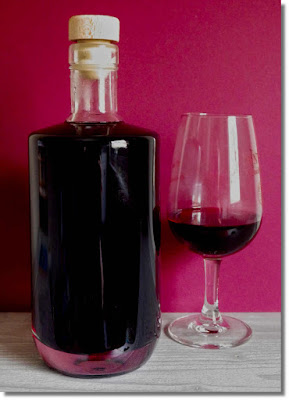Boysenberry Liqueur
For some reason hybrid berries such as tayberries, loganberries and boysenberries don't seem to be too popular amongst gardeners in this country. I bought a single boysenberry plant about 7 years ago and I get a heavy crop of berries every year in return for very little effort. And when I see a decent crop of berries then I usually think liqueur.
Every autumn I make a bottle or so of foraged blackberry liqueur (crème de mûre) and I've used that same process to make a crème de mûre de boysen. I know that you can simply steep fruit in vodka and sugar and that can be very pleasing but when liqueurs made that way are added to kirs and cocktails they just don't taste right to me. I suppose that's what happens after many years of drinking French crème de mûre and crème de cassis. So I stick to this traditional French method. You don't have to use boysenberries, it will work with other similar berries such as cultivated blackberries or tayberries.
This liqueur is very welcome when drizzled on ice cream or added to other desserts but it comes into its own when combined with white wine in a kir. You could also try using it instead of cassis in red wine kirs, often known as a Cardinal(e) or Communard; they're best made with a lighter style of red wine. Or you could use it in more elaborate cocktails such as the esteemed Bramble (gin, lemon juice, sugar syrup, boysenberry liqueur). Personally, I'm particularly fond of the following variant of the Blackhawk cocktail.
Shake 60 ml of vodka, 20 ml lime juice and 20 ml of boysenberry liqueur (or crème de mûre) with ice and strain into whatever cocktail glass you fancy. Decorate with a slice of lime, if you can be bothered.
Compared to many blackberries, the boysenberries bring a slightly sharper quality to the drink and more of a raspberry character. If you're familiar with the taste of boysenberries then this won't come as a surprise. Use a lighter red wine when making this liqueur, such as a cheap but drinkable pinot noir. If you use large, juicy, cultivated berries then expect a yield of around 850 - 900 ml from this recipe but there will probably be a little less if you use foraged or small berries.
500 g boysenberries (or whatever juicy berry you want to try), washed and dried
500 ml red wine
175 ml vodka
400 g sugar
Put the boysenberries in a non-reactive bowl and crush them lightly. I use a potato masher to do the job. Transfer the berries to a jar that you can seal tightly and pour over the wine and vodka. Seal the jar and leave in a cool, dark place for around 3 days, shaking the jar every now and then. If you don't have a suitable jar to hand, then leave the berries, wine and vodka in a bowl, cover tightly and remember to stir the contents regularly.
Strain the mixture through a non-reactive sieve and discard the berries. (You could use the berries in fruit desserts but much of the characteristic flavour will have gone in my experience). Strain the juice again, through muslin this time, into a large, non-reactive saucepan. This will take a while. Add the sugar and place the saucepan on a medium heat. Bring the mixture to the boil while stirring to dissolve the sugar.
Once the sugar has dissolved and the mixture has reached boiling point, turn down the heat and simmer gently for 5 - 10 minutes. At the end of this time the mixture should be a little syrupy but not too thick or gloopy. It's difficult to be precise about the timing here because it depends on how much juice the berries have produced.
Allow the liqueur to cool, pour into sterilised bottles and seal. It doesn't really need to mature in the bottle so feel free to use immediately. Store, tightly sealed, away from too much light or heat. I know that this liqueur will keep very well for at least six months, but it may well last longer.






This sounds good. Are they Scandinavian in origin - boysenberries I mean?
ReplyDeleteActually, boysenberries were created almost 100 years ago in California by Mr Boysen. It seems that he didn't gain much financially from his complex hybridising work but there is a park in California named in his honour. Personally, I can't think of many better ways to honour someone. I'm certainly very grateful to him.
Delete